LSME505 Business Finance: Costing, Budgeting & Investment Decisions
VerifiedAdded on 2023/06/11
|12
|2611
|161
Case Study
AI Summary
This business finance case study for Lobelia Ltd. analyzes costing methods, break-even points, margin of safety, and profit determination using marginal and absorption costing. It includes a memo to the financial manager and a reconciliation statement. The study further examines the importance of standard costing and variance analysis for Apparel Plc, calculating variances and preparing budgets for a target production of 10,000 units. The analysis covers direct material, direct labor, and overhead budgeting, providing a comprehensive overview of financial management techniques and their application in a business context. Desklib provides a platform for students to access similar solved assignments and past papers.
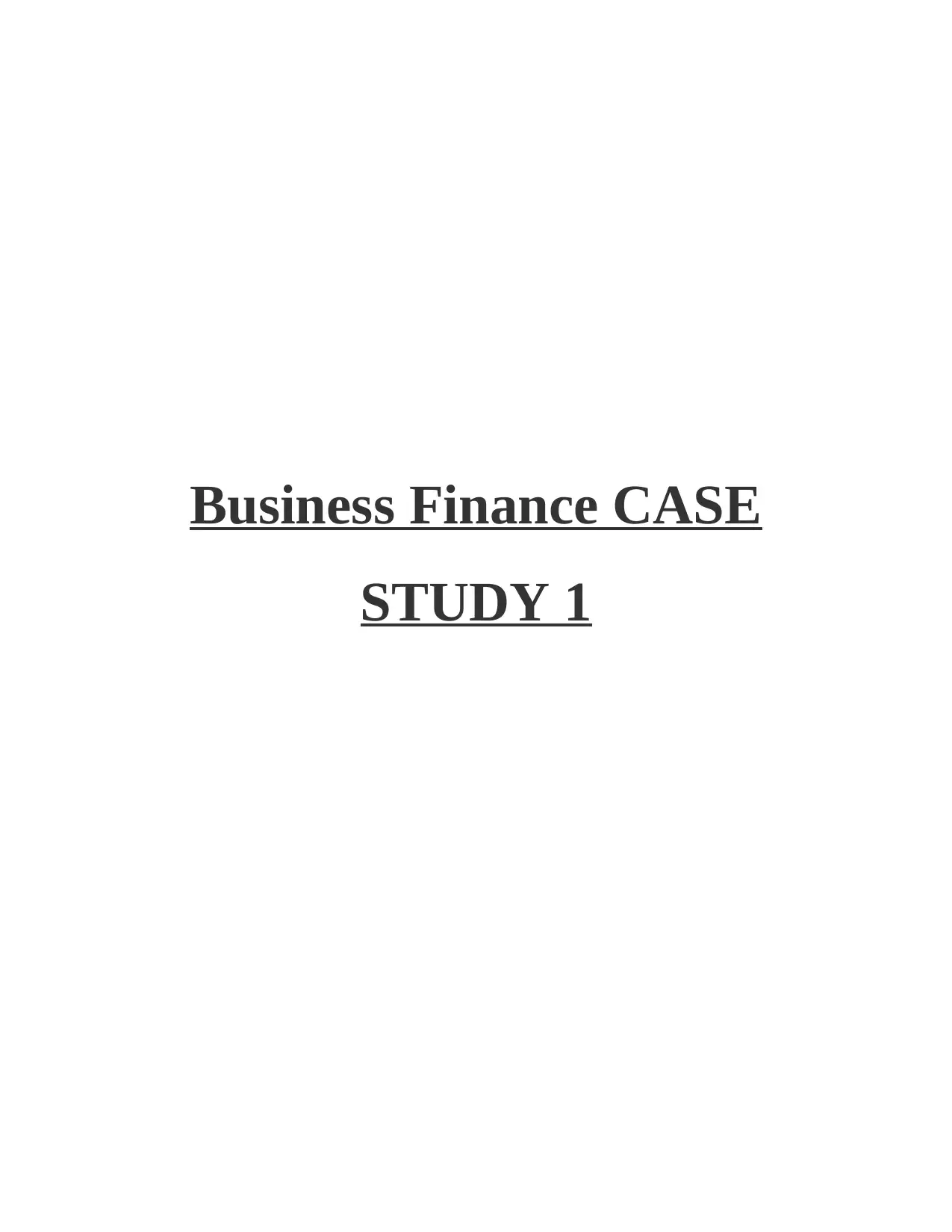
Business Finance CASE
STUDY 1
STUDY 1
Paraphrase This Document
Need a fresh take? Get an instant paraphrase of this document with our AI Paraphraser
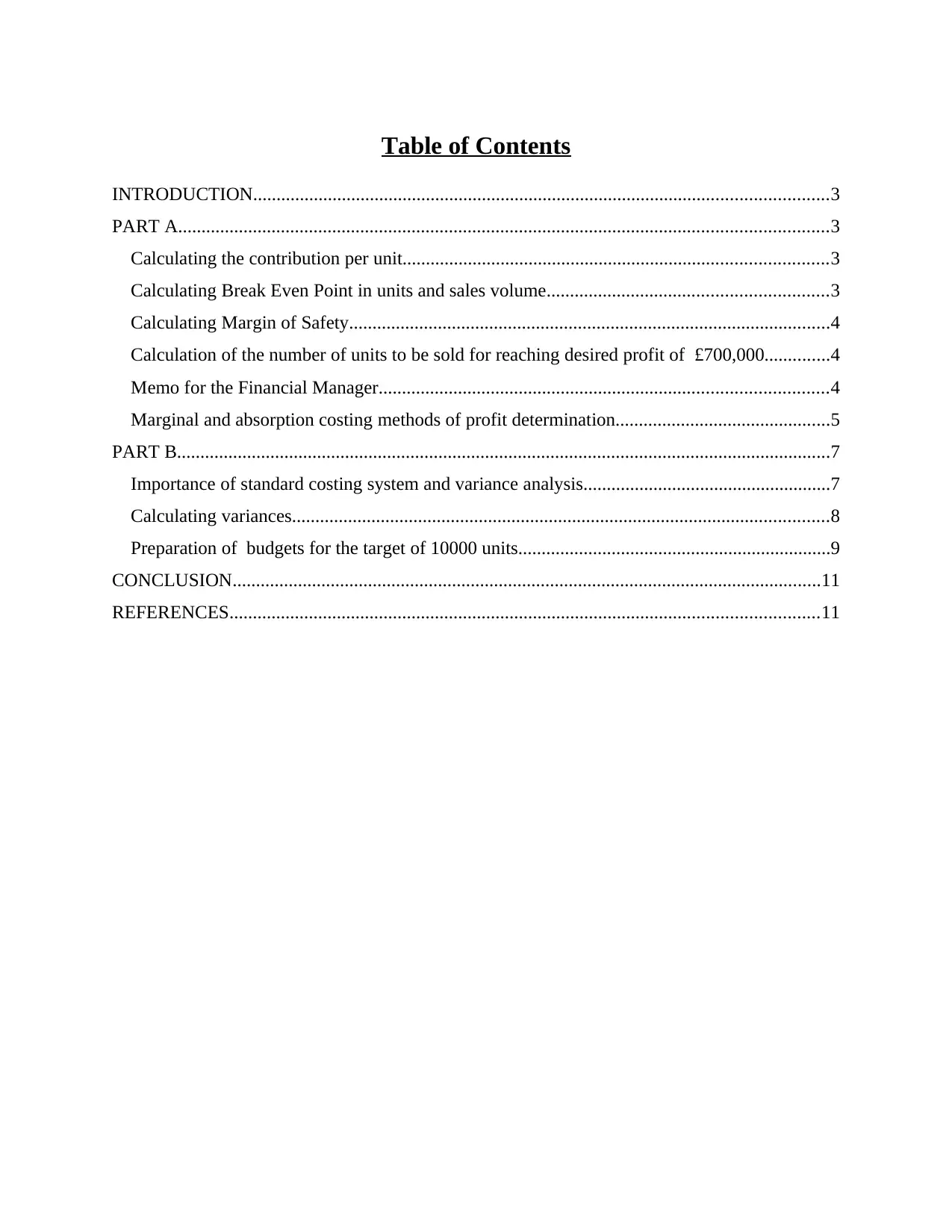
Table of Contents
INTRODUCTION...........................................................................................................................3
PART A...........................................................................................................................................3
Calculating the contribution per unit...........................................................................................3
Calculating Break Even Point in units and sales volume............................................................3
Calculating Margin of Safety.......................................................................................................4
Calculation of the number of units to be sold for reaching desired profit of £700,000..............4
Memo for the Financial Manager................................................................................................4
Marginal and absorption costing methods of profit determination..............................................5
PART B............................................................................................................................................7
Importance of standard costing system and variance analysis.....................................................7
Calculating variances...................................................................................................................8
Preparation of budgets for the target of 10000 units...................................................................9
CONCLUSION..............................................................................................................................11
REFERENCES..............................................................................................................................11
INTRODUCTION...........................................................................................................................3
PART A...........................................................................................................................................3
Calculating the contribution per unit...........................................................................................3
Calculating Break Even Point in units and sales volume............................................................3
Calculating Margin of Safety.......................................................................................................4
Calculation of the number of units to be sold for reaching desired profit of £700,000..............4
Memo for the Financial Manager................................................................................................4
Marginal and absorption costing methods of profit determination..............................................5
PART B............................................................................................................................................7
Importance of standard costing system and variance analysis.....................................................7
Calculating variances...................................................................................................................8
Preparation of budgets for the target of 10000 units...................................................................9
CONCLUSION..............................................................................................................................11
REFERENCES..............................................................................................................................11
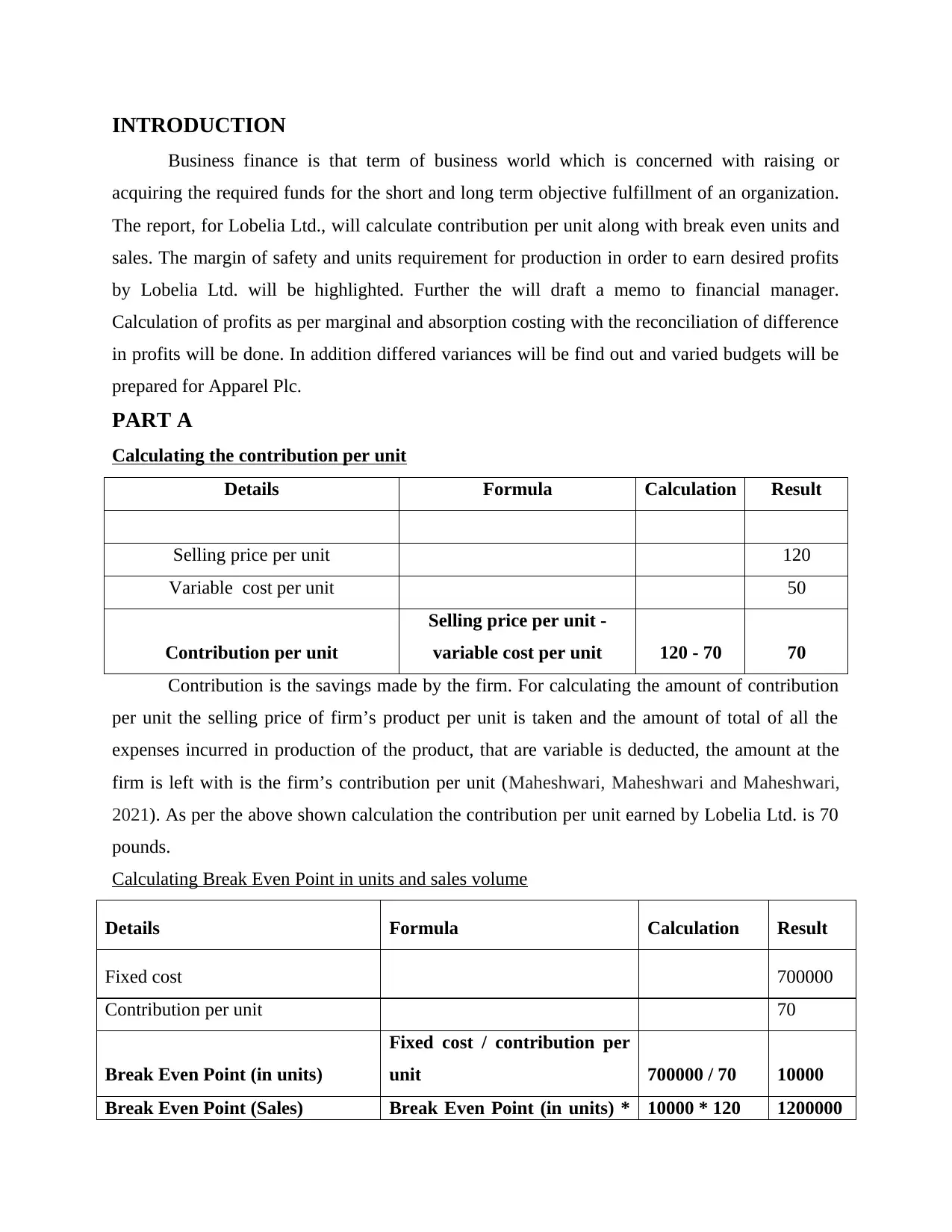
INTRODUCTION
Business finance is that term of business world which is concerned with raising or
acquiring the required funds for the short and long term objective fulfillment of an organization.
The report, for Lobelia Ltd., will calculate contribution per unit along with break even units and
sales. The margin of safety and units requirement for production in order to earn desired profits
by Lobelia Ltd. will be highlighted. Further the will draft a memo to financial manager.
Calculation of profits as per marginal and absorption costing with the reconciliation of difference
in profits will be done. In addition differed variances will be find out and varied budgets will be
prepared for Apparel Plc.
PART A
Calculating the contribution per unit
Details Formula Calculation Result
Selling price per unit 120
Variable cost per unit 50
Contribution per unit
Selling price per unit -
variable cost per unit 120 - 70 70
Contribution is the savings made by the firm. For calculating the amount of contribution
per unit the selling price of firm’s product per unit is taken and the amount of total of all the
expenses incurred in production of the product, that are variable is deducted, the amount at the
firm is left with is the firm’s contribution per unit (Maheshwari, Maheshwari and Maheshwari,
2021). As per the above shown calculation the contribution per unit earned by Lobelia Ltd. is 70
pounds.
Calculating Break Even Point in units and sales volume
Details Formula Calculation Result
Fixed cost 700000
Contribution per unit 70
Break Even Point (in units)
Fixed cost / contribution per
unit 700000 / 70 10000
Break Even Point (Sales) Break Even Point (in units) * 10000 * 120 1200000
Business finance is that term of business world which is concerned with raising or
acquiring the required funds for the short and long term objective fulfillment of an organization.
The report, for Lobelia Ltd., will calculate contribution per unit along with break even units and
sales. The margin of safety and units requirement for production in order to earn desired profits
by Lobelia Ltd. will be highlighted. Further the will draft a memo to financial manager.
Calculation of profits as per marginal and absorption costing with the reconciliation of difference
in profits will be done. In addition differed variances will be find out and varied budgets will be
prepared for Apparel Plc.
PART A
Calculating the contribution per unit
Details Formula Calculation Result
Selling price per unit 120
Variable cost per unit 50
Contribution per unit
Selling price per unit -
variable cost per unit 120 - 70 70
Contribution is the savings made by the firm. For calculating the amount of contribution
per unit the selling price of firm’s product per unit is taken and the amount of total of all the
expenses incurred in production of the product, that are variable is deducted, the amount at the
firm is left with is the firm’s contribution per unit (Maheshwari, Maheshwari and Maheshwari,
2021). As per the above shown calculation the contribution per unit earned by Lobelia Ltd. is 70
pounds.
Calculating Break Even Point in units and sales volume
Details Formula Calculation Result
Fixed cost 700000
Contribution per unit 70
Break Even Point (in units)
Fixed cost / contribution per
unit 700000 / 70 10000
Break Even Point (Sales) Break Even Point (in units) * 10000 * 120 1200000
⊘ This is a preview!⊘
Do you want full access?
Subscribe today to unlock all pages.

Trusted by 1+ million students worldwide
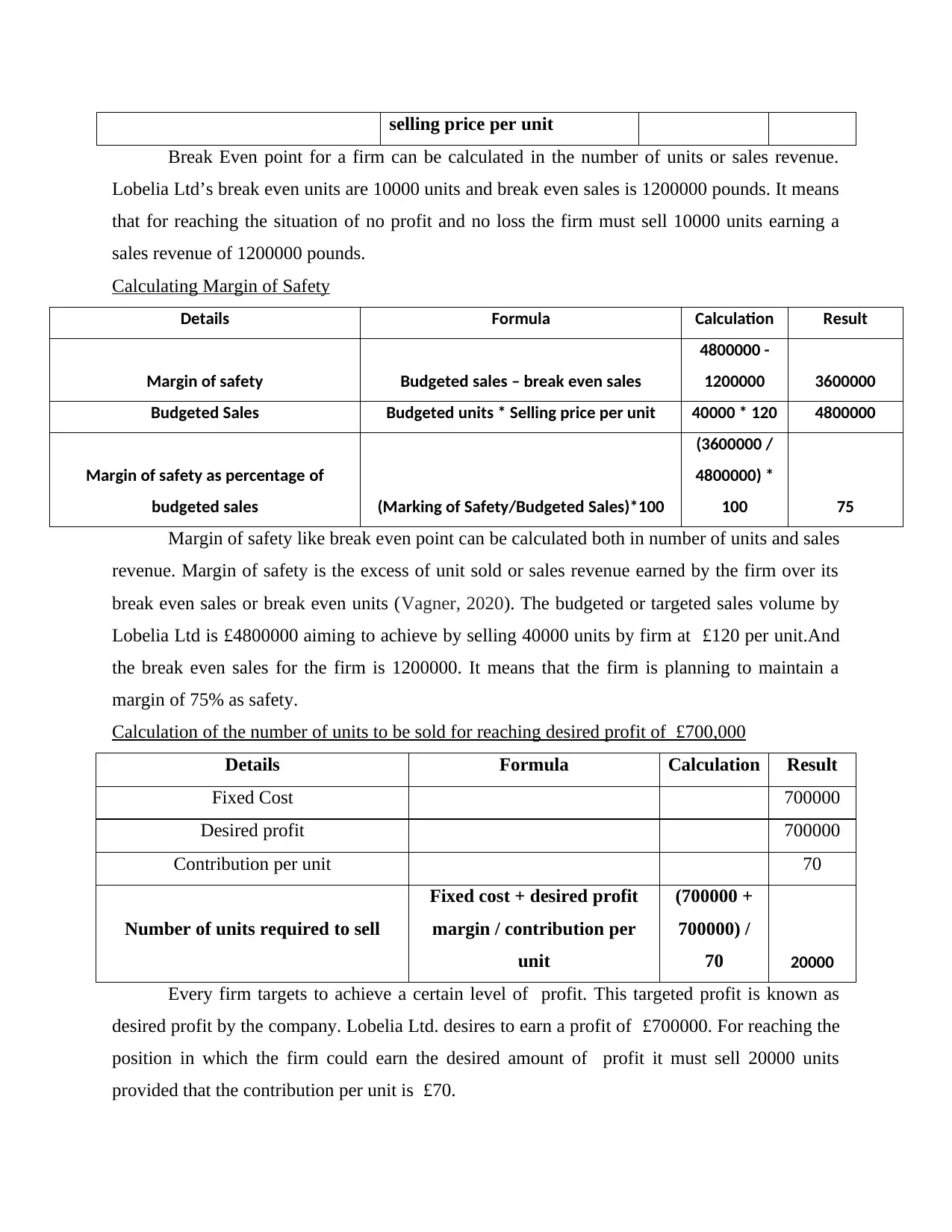
selling price per unit
Break Even point for a firm can be calculated in the number of units or sales revenue.
Lobelia Ltd’s break even units are 10000 units and break even sales is 1200000 pounds. It means
that for reaching the situation of no profit and no loss the firm must sell 10000 units earning a
sales revenue of 1200000 pounds.
Calculating Margin of Safety
Details Formula Calculation Result
Margin of safety Budgeted sales – break even sales
4800000 -
1200000 3600000
Budgeted Sales Budgeted units * Selling price per unit 40000 * 120 4800000
Margin of safety as percentage of
budgeted sales (Marking of Safety/Budgeted Sales)*100
(3600000 /
4800000) *
100 75
Margin of safety like break even point can be calculated both in number of units and sales
revenue. Margin of safety is the excess of unit sold or sales revenue earned by the firm over its
break even sales or break even units (Vagner, 2020). The budgeted or targeted sales volume by
Lobelia Ltd is £4800000 aiming to achieve by selling 40000 units by firm at £120 per unit.And
the break even sales for the firm is 1200000. It means that the firm is planning to maintain a
margin of 75% as safety.
Calculation of the number of units to be sold for reaching desired profit of £700,000
Details Formula Calculation Result
Fixed Cost 700000
Desired profit 700000
Contribution per unit 70
Number of units required to sell
Fixed cost + desired profit
margin / contribution per
unit
(700000 +
700000) /
70 20000
Every firm targets to achieve a certain level of profit. This targeted profit is known as
desired profit by the company. Lobelia Ltd. desires to earn a profit of £700000. For reaching the
position in which the firm could earn the desired amount of profit it must sell 20000 units
provided that the contribution per unit is £70.
Break Even point for a firm can be calculated in the number of units or sales revenue.
Lobelia Ltd’s break even units are 10000 units and break even sales is 1200000 pounds. It means
that for reaching the situation of no profit and no loss the firm must sell 10000 units earning a
sales revenue of 1200000 pounds.
Calculating Margin of Safety
Details Formula Calculation Result
Margin of safety Budgeted sales – break even sales
4800000 -
1200000 3600000
Budgeted Sales Budgeted units * Selling price per unit 40000 * 120 4800000
Margin of safety as percentage of
budgeted sales (Marking of Safety/Budgeted Sales)*100
(3600000 /
4800000) *
100 75
Margin of safety like break even point can be calculated both in number of units and sales
revenue. Margin of safety is the excess of unit sold or sales revenue earned by the firm over its
break even sales or break even units (Vagner, 2020). The budgeted or targeted sales volume by
Lobelia Ltd is £4800000 aiming to achieve by selling 40000 units by firm at £120 per unit.And
the break even sales for the firm is 1200000. It means that the firm is planning to maintain a
margin of 75% as safety.
Calculation of the number of units to be sold for reaching desired profit of £700,000
Details Formula Calculation Result
Fixed Cost 700000
Desired profit 700000
Contribution per unit 70
Number of units required to sell
Fixed cost + desired profit
margin / contribution per
unit
(700000 +
700000) /
70 20000
Every firm targets to achieve a certain level of profit. This targeted profit is known as
desired profit by the company. Lobelia Ltd. desires to earn a profit of £700000. For reaching the
position in which the firm could earn the desired amount of profit it must sell 20000 units
provided that the contribution per unit is £70.
Paraphrase This Document
Need a fresh take? Get an instant paraphrase of this document with our AI Paraphraser

Memo for the Financial Manager
It is reported to the Financial Manager of Lobelia Ltd. that contribution is very important
for the firm in keeping a track on its product’s profitability. The amount of contribution of a
product tells the value that is available with the firm with the sale of the product after deducting
all the variable cost of production in order to cover the fixed costs of the firm. After covering the
fixed costs the amount that is left is the amount of profits earned by the firm (Putri and et.al.,
2021). So it is reported to the financial manager that contribution is vital for calculating the
profits of the firm. Contribution is further closely linked with the profit sales volume ratio.
Marginal and absorption costing methods of profit determination
Marginal Costing
Cost per Unit Calculation
Details Price/ Cost per Unit
Selling Price 22
Direct Material 7
Direct labour 9
Variable overhead 3
Total 19
In marginal costing technique cost per unit is calculated by adding the per unit values of
all the variable expenses. The variable expenses here are direct material, direct labour and
variable overhead.
Cost of Goods Sold
Details Number of Units Cost
Stock in the Beginning 0 0
Add: Purchases 4800 4800 * 19 = 91200
Less: Stock at the End 400 400 * 19 = 7600
COGS 4400 4400 * 19 = 83600
COGS or cost of goods sold is calculated by adding the value purchases during the year
in the value of opening inventory and deducting closing inventory.
INCOME STATEMENT
PARTICULARS DETAILS AMOUNT
Sales Revenue 4400 * 22 96800
It is reported to the Financial Manager of Lobelia Ltd. that contribution is very important
for the firm in keeping a track on its product’s profitability. The amount of contribution of a
product tells the value that is available with the firm with the sale of the product after deducting
all the variable cost of production in order to cover the fixed costs of the firm. After covering the
fixed costs the amount that is left is the amount of profits earned by the firm (Putri and et.al.,
2021). So it is reported to the financial manager that contribution is vital for calculating the
profits of the firm. Contribution is further closely linked with the profit sales volume ratio.
Marginal and absorption costing methods of profit determination
Marginal Costing
Cost per Unit Calculation
Details Price/ Cost per Unit
Selling Price 22
Direct Material 7
Direct labour 9
Variable overhead 3
Total 19
In marginal costing technique cost per unit is calculated by adding the per unit values of
all the variable expenses. The variable expenses here are direct material, direct labour and
variable overhead.
Cost of Goods Sold
Details Number of Units Cost
Stock in the Beginning 0 0
Add: Purchases 4800 4800 * 19 = 91200
Less: Stock at the End 400 400 * 19 = 7600
COGS 4400 4400 * 19 = 83600
COGS or cost of goods sold is calculated by adding the value purchases during the year
in the value of opening inventory and deducting closing inventory.
INCOME STATEMENT
PARTICULARS DETAILS AMOUNT
Sales Revenue 4400 * 22 96800
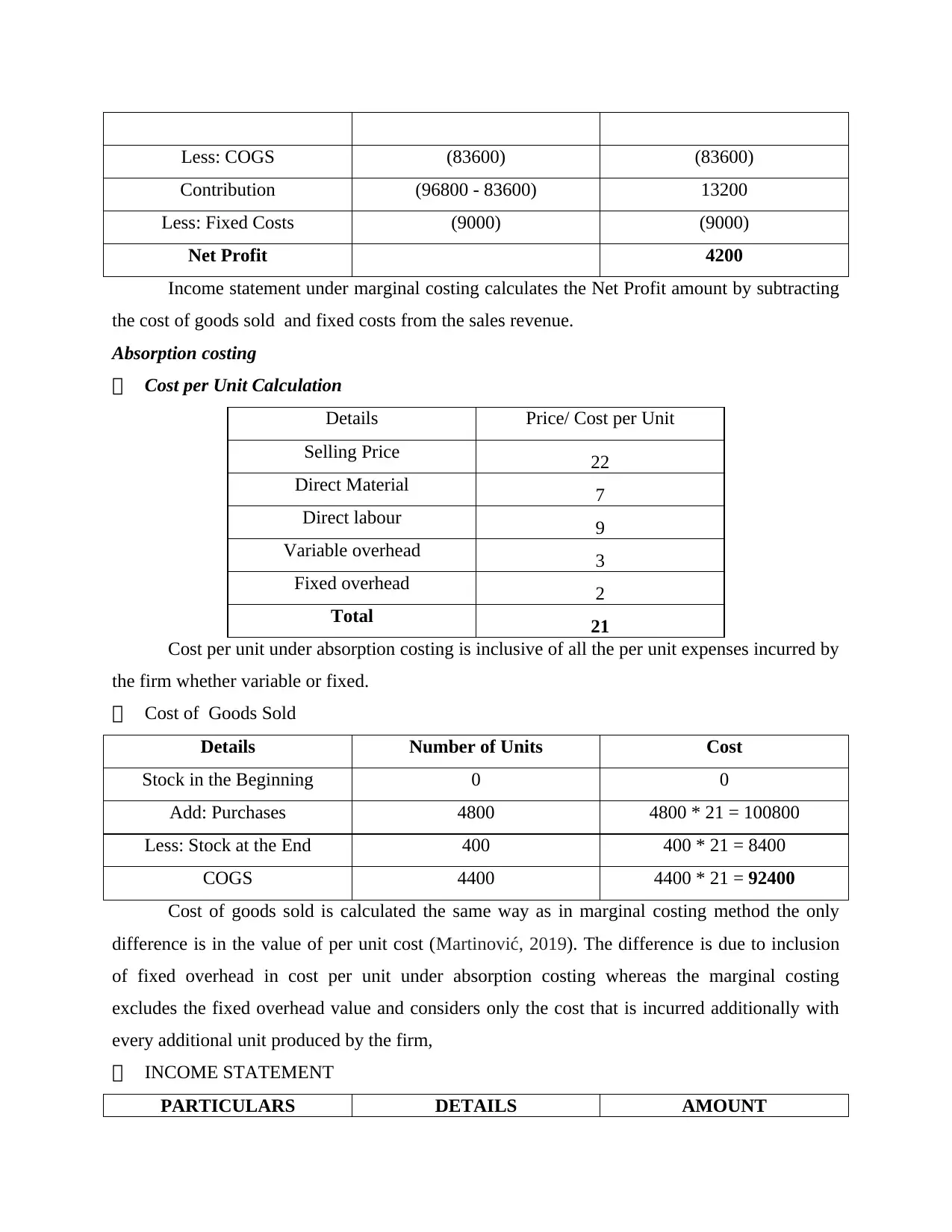
Less: COGS (83600) (83600)
Contribution (96800 - 83600) 13200
Less: Fixed Costs (9000) (9000)
Net Profit 4200
Income statement under marginal costing calculates the Net Profit amount by subtracting
the cost of goods sold and fixed costs from the sales revenue.
Absorption costing
Cost per Unit Calculation
Details Price/ Cost per Unit
Selling Price 22
Direct Material 7
Direct labour 9
Variable overhead 3
Fixed overhead 2
Total 21
Cost per unit under absorption costing is inclusive of all the per unit expenses incurred by
the firm whether variable or fixed.
Cost of Goods Sold
Details Number of Units Cost
Stock in the Beginning 0 0
Add: Purchases 4800 4800 * 21 = 100800
Less: Stock at the End 400 400 * 21 = 8400
COGS 4400 4400 * 21 = 92400
Cost of goods sold is calculated the same way as in marginal costing method the only
difference is in the value of per unit cost (Martinović, 2019). The difference is due to inclusion
of fixed overhead in cost per unit under absorption costing whereas the marginal costing
excludes the fixed overhead value and considers only the cost that is incurred additionally with
every additional unit produced by the firm,
INCOME STATEMENT
PARTICULARS DETAILS AMOUNT
Contribution (96800 - 83600) 13200
Less: Fixed Costs (9000) (9000)
Net Profit 4200
Income statement under marginal costing calculates the Net Profit amount by subtracting
the cost of goods sold and fixed costs from the sales revenue.
Absorption costing
Cost per Unit Calculation
Details Price/ Cost per Unit
Selling Price 22
Direct Material 7
Direct labour 9
Variable overhead 3
Fixed overhead 2
Total 21
Cost per unit under absorption costing is inclusive of all the per unit expenses incurred by
the firm whether variable or fixed.
Cost of Goods Sold
Details Number of Units Cost
Stock in the Beginning 0 0
Add: Purchases 4800 4800 * 21 = 100800
Less: Stock at the End 400 400 * 21 = 8400
COGS 4400 4400 * 21 = 92400
Cost of goods sold is calculated the same way as in marginal costing method the only
difference is in the value of per unit cost (Martinović, 2019). The difference is due to inclusion
of fixed overhead in cost per unit under absorption costing whereas the marginal costing
excludes the fixed overhead value and considers only the cost that is incurred additionally with
every additional unit produced by the firm,
INCOME STATEMENT
PARTICULARS DETAILS AMOUNT
⊘ This is a preview!⊘
Do you want full access?
Subscribe today to unlock all pages.

Trusted by 1+ million students worldwide
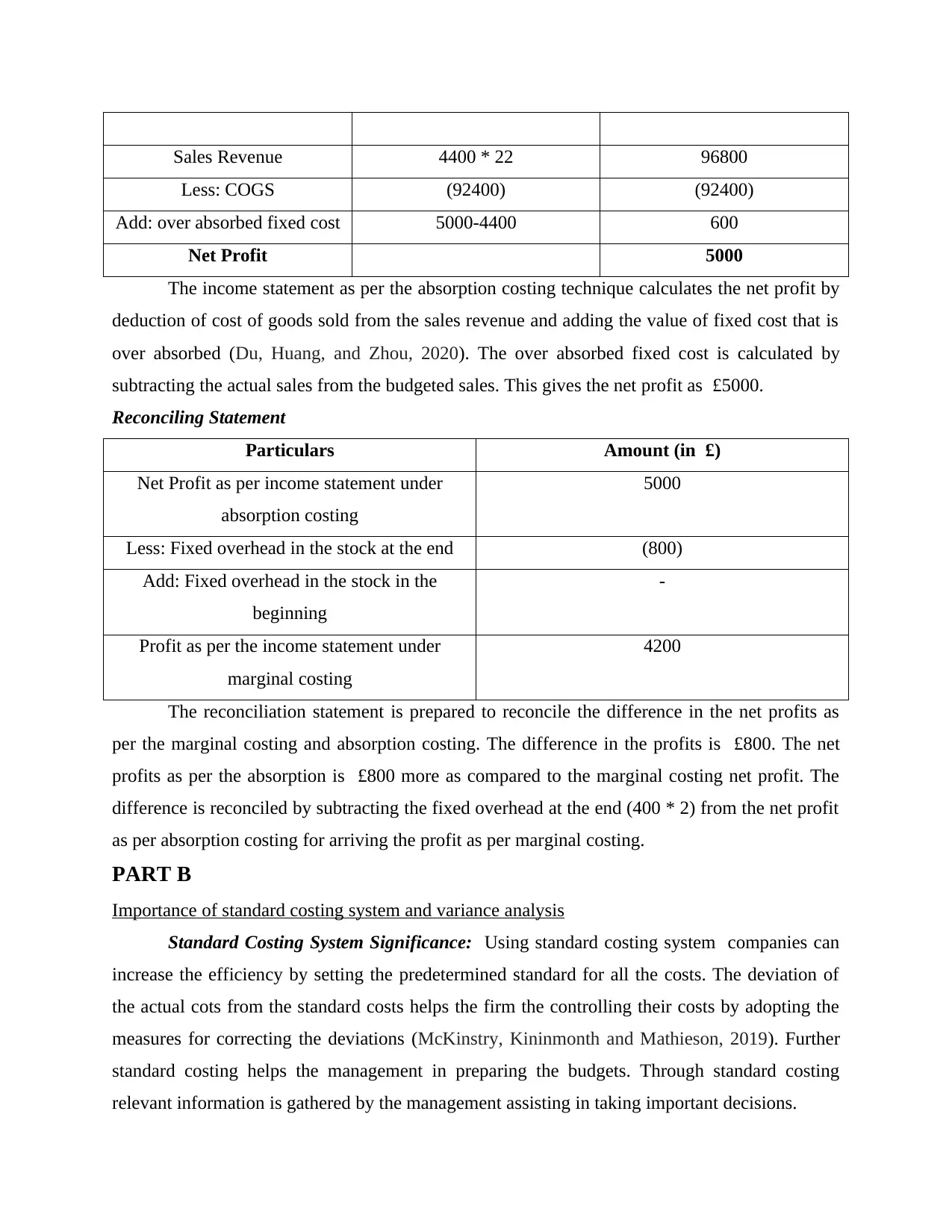
Sales Revenue 4400 * 22 96800
Less: COGS (92400) (92400)
Add: over absorbed fixed cost 5000-4400 600
Net Profit 5000
The income statement as per the absorption costing technique calculates the net profit by
deduction of cost of goods sold from the sales revenue and adding the value of fixed cost that is
over absorbed (Du, Huang, and Zhou, 2020). The over absorbed fixed cost is calculated by
subtracting the actual sales from the budgeted sales. This gives the net profit as £5000.
Reconciling Statement
Particulars Amount (in £)
Net Profit as per income statement under
absorption costing
5000
Less: Fixed overhead in the stock at the end (800)
Add: Fixed overhead in the stock in the
beginning
-
Profit as per the income statement under
marginal costing
4200
The reconciliation statement is prepared to reconcile the difference in the net profits as
per the marginal costing and absorption costing. The difference in the profits is £800. The net
profits as per the absorption is £800 more as compared to the marginal costing net profit. The
difference is reconciled by subtracting the fixed overhead at the end (400 * 2) from the net profit
as per absorption costing for arriving the profit as per marginal costing.
PART B
Importance of standard costing system and variance analysis
Standard Costing System Significance: Using standard costing system companies can
increase the efficiency by setting the predetermined standard for all the costs. The deviation of
the actual cots from the standard costs helps the firm the controlling their costs by adopting the
measures for correcting the deviations (McKinstry, Kininmonth and Mathieson, 2019). Further
standard costing helps the management in preparing the budgets. Through standard costing
relevant information is gathered by the management assisting in taking important decisions.
Less: COGS (92400) (92400)
Add: over absorbed fixed cost 5000-4400 600
Net Profit 5000
The income statement as per the absorption costing technique calculates the net profit by
deduction of cost of goods sold from the sales revenue and adding the value of fixed cost that is
over absorbed (Du, Huang, and Zhou, 2020). The over absorbed fixed cost is calculated by
subtracting the actual sales from the budgeted sales. This gives the net profit as £5000.
Reconciling Statement
Particulars Amount (in £)
Net Profit as per income statement under
absorption costing
5000
Less: Fixed overhead in the stock at the end (800)
Add: Fixed overhead in the stock in the
beginning
-
Profit as per the income statement under
marginal costing
4200
The reconciliation statement is prepared to reconcile the difference in the net profits as
per the marginal costing and absorption costing. The difference in the profits is £800. The net
profits as per the absorption is £800 more as compared to the marginal costing net profit. The
difference is reconciled by subtracting the fixed overhead at the end (400 * 2) from the net profit
as per absorption costing for arriving the profit as per marginal costing.
PART B
Importance of standard costing system and variance analysis
Standard Costing System Significance: Using standard costing system companies can
increase the efficiency by setting the predetermined standard for all the costs. The deviation of
the actual cots from the standard costs helps the firm the controlling their costs by adopting the
measures for correcting the deviations (McKinstry, Kininmonth and Mathieson, 2019). Further
standard costing helps the management in preparing the budgets. Through standard costing
relevant information is gathered by the management assisting in taking important decisions.
Paraphrase This Document
Need a fresh take? Get an instant paraphrase of this document with our AI Paraphraser
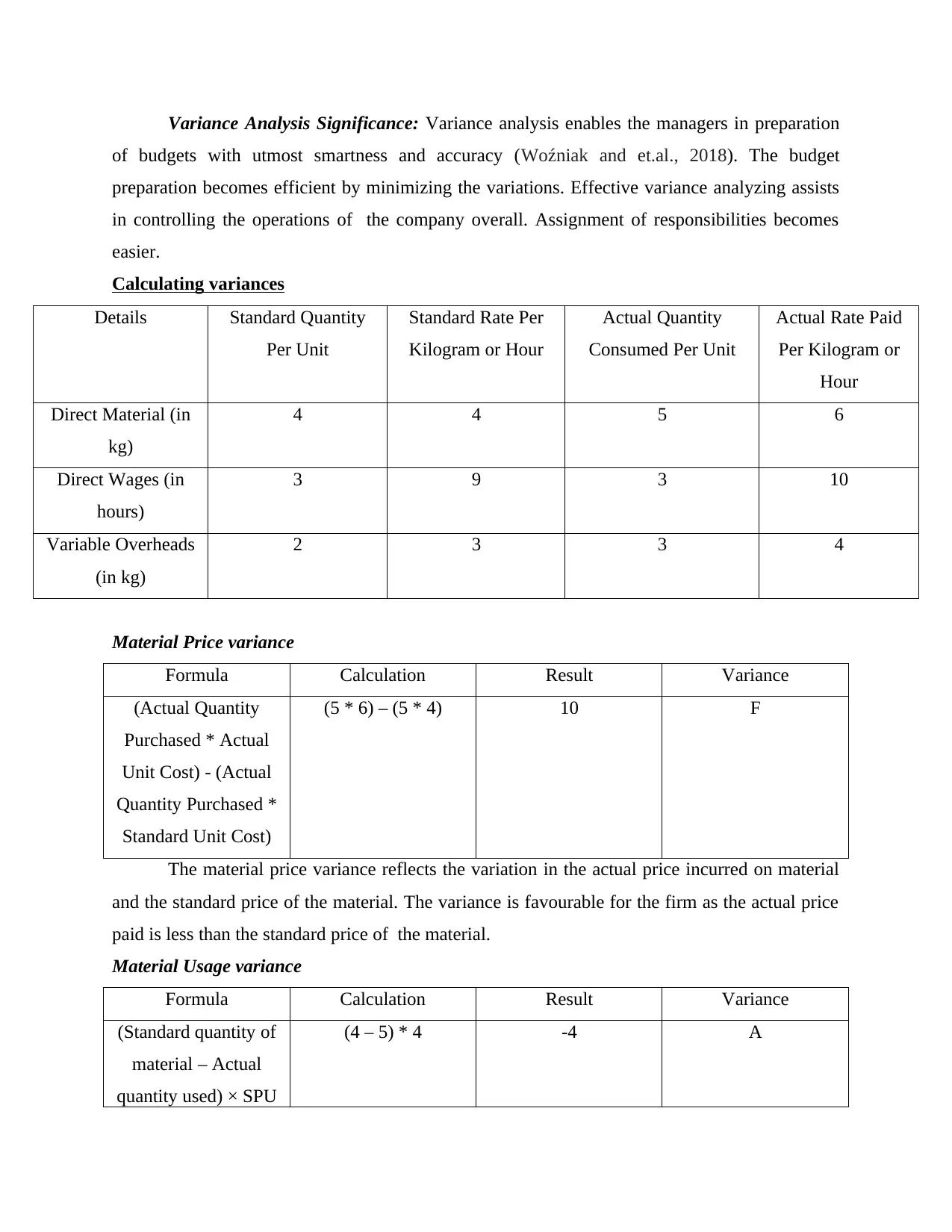
Variance Analysis Significance: Variance analysis enables the managers in preparation
of budgets with utmost smartness and accuracy (Woźniak and et.al., 2018). The budget
preparation becomes efficient by minimizing the variations. Effective variance analyzing assists
in controlling the operations of the company overall. Assignment of responsibilities becomes
easier.
Calculating variances
Details Standard Quantity
Per Unit
Standard Rate Per
Kilogram or Hour
Actual Quantity
Consumed Per Unit
Actual Rate Paid
Per Kilogram or
Hour
Direct Material (in
kg)
4 4 5 6
Direct Wages (in
hours)
3 9 3 10
Variable Overheads
(in kg)
2 3 3 4
Material Price variance
Formula Calculation Result Variance
(Actual Quantity
Purchased * Actual
Unit Cost) - (Actual
Quantity Purchased *
Standard Unit Cost)
(5 * 6) – (5 * 4) 10 F
The material price variance reflects the variation in the actual price incurred on material
and the standard price of the material. The variance is favourable for the firm as the actual price
paid is less than the standard price of the material.
Material Usage variance
Formula Calculation Result Variance
(Standard quantity of
material – Actual
quantity used) × SPU
(4 – 5) * 4 -4 A
of budgets with utmost smartness and accuracy (Woźniak and et.al., 2018). The budget
preparation becomes efficient by minimizing the variations. Effective variance analyzing assists
in controlling the operations of the company overall. Assignment of responsibilities becomes
easier.
Calculating variances
Details Standard Quantity
Per Unit
Standard Rate Per
Kilogram or Hour
Actual Quantity
Consumed Per Unit
Actual Rate Paid
Per Kilogram or
Hour
Direct Material (in
kg)
4 4 5 6
Direct Wages (in
hours)
3 9 3 10
Variable Overheads
(in kg)
2 3 3 4
Material Price variance
Formula Calculation Result Variance
(Actual Quantity
Purchased * Actual
Unit Cost) - (Actual
Quantity Purchased *
Standard Unit Cost)
(5 * 6) – (5 * 4) 10 F
The material price variance reflects the variation in the actual price incurred on material
and the standard price of the material. The variance is favourable for the firm as the actual price
paid is less than the standard price of the material.
Material Usage variance
Formula Calculation Result Variance
(Standard quantity of
material – Actual
quantity used) × SPU
(4 – 5) * 4 -4 A
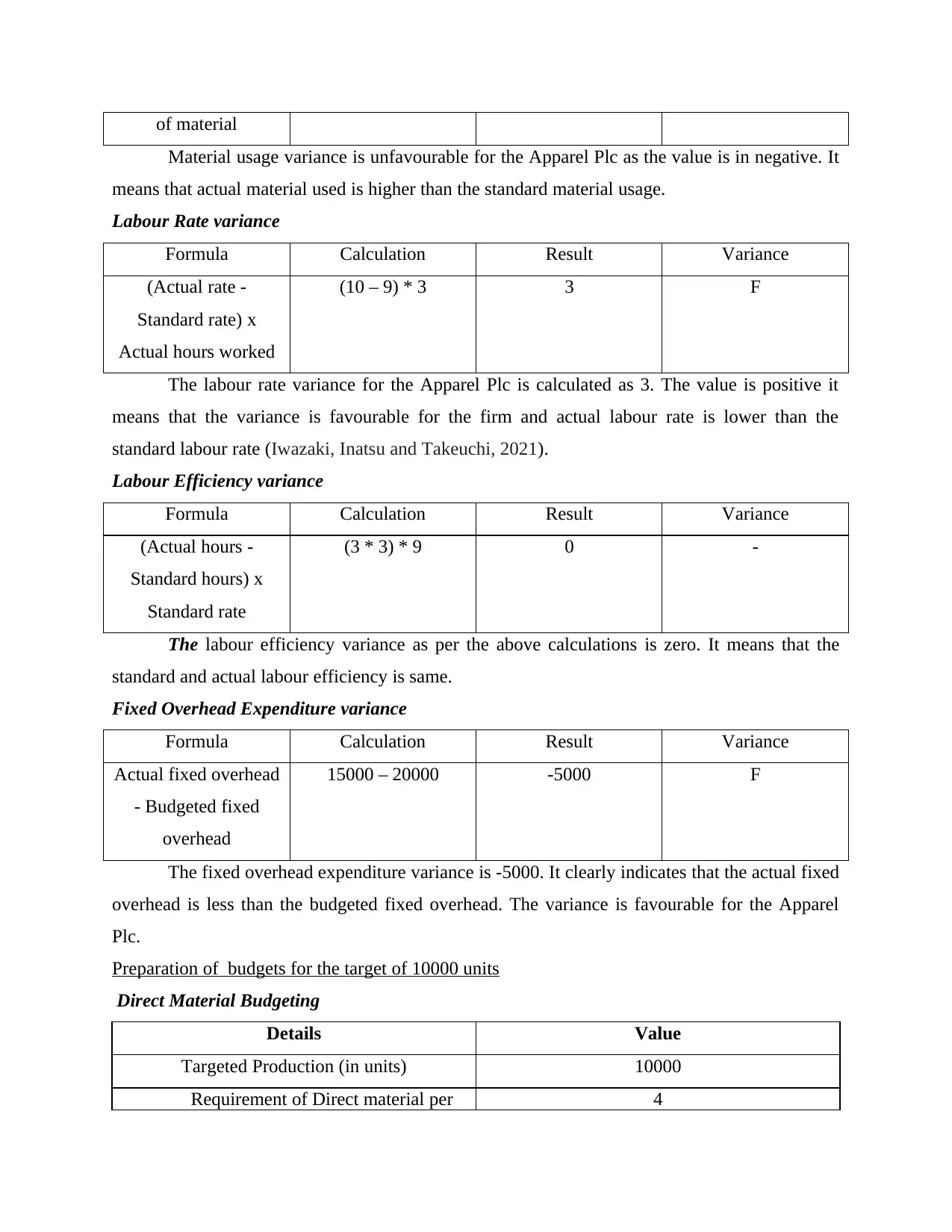
of material
Material usage variance is unfavourable for the Apparel Plc as the value is in negative. It
means that actual material used is higher than the standard material usage.
Labour Rate variance
Formula Calculation Result Variance
(Actual rate -
Standard rate) x
Actual hours worked
(10 – 9) * 3 3 F
The labour rate variance for the Apparel Plc is calculated as 3. The value is positive it
means that the variance is favourable for the firm and actual labour rate is lower than the
standard labour rate (Iwazaki, Inatsu and Takeuchi, 2021).
Labour Efficiency variance
Formula Calculation Result Variance
(Actual hours -
Standard hours) x
Standard rate
(3 * 3) * 9 0 -
The labour efficiency variance as per the above calculations is zero. It means that the
standard and actual labour efficiency is same.
Fixed Overhead Expenditure variance
Formula Calculation Result Variance
Actual fixed overhead
- Budgeted fixed
overhead
15000 – 20000 -5000 F
The fixed overhead expenditure variance is -5000. It clearly indicates that the actual fixed
overhead is less than the budgeted fixed overhead. The variance is favourable for the Apparel
Plc.
Preparation of budgets for the target of 10000 units
Direct Material Budgeting
Details Value
Targeted Production (in units) 10000
Requirement of Direct material per 4
Material usage variance is unfavourable for the Apparel Plc as the value is in negative. It
means that actual material used is higher than the standard material usage.
Labour Rate variance
Formula Calculation Result Variance
(Actual rate -
Standard rate) x
Actual hours worked
(10 – 9) * 3 3 F
The labour rate variance for the Apparel Plc is calculated as 3. The value is positive it
means that the variance is favourable for the firm and actual labour rate is lower than the
standard labour rate (Iwazaki, Inatsu and Takeuchi, 2021).
Labour Efficiency variance
Formula Calculation Result Variance
(Actual hours -
Standard hours) x
Standard rate
(3 * 3) * 9 0 -
The labour efficiency variance as per the above calculations is zero. It means that the
standard and actual labour efficiency is same.
Fixed Overhead Expenditure variance
Formula Calculation Result Variance
Actual fixed overhead
- Budgeted fixed
overhead
15000 – 20000 -5000 F
The fixed overhead expenditure variance is -5000. It clearly indicates that the actual fixed
overhead is less than the budgeted fixed overhead. The variance is favourable for the Apparel
Plc.
Preparation of budgets for the target of 10000 units
Direct Material Budgeting
Details Value
Targeted Production (in units) 10000
Requirement of Direct material per 4
⊘ This is a preview!⊘
Do you want full access?
Subscribe today to unlock all pages.

Trusted by 1+ million students worldwide
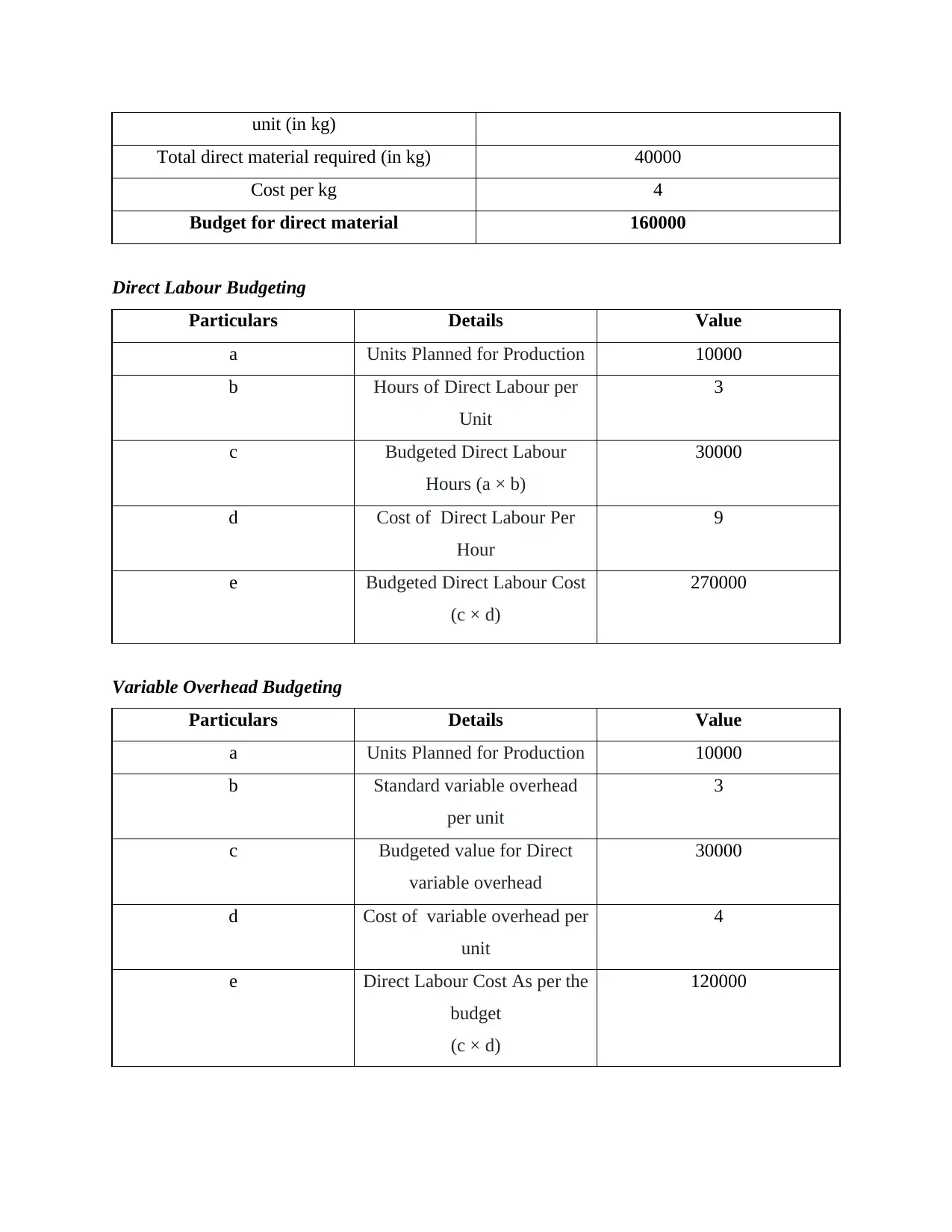
unit (in kg)
Total direct material required (in kg) 40000
Cost per kg 4
Budget for direct material 160000
Direct Labour Budgeting
Particulars Details Value
a Units Planned for Production 10000
b Hours of Direct Labour per
Unit
3
c Budgeted Direct Labour
Hours (a × b)
30000
d Cost of Direct Labour Per
Hour
9
e Budgeted Direct Labour Cost
(c × d)
270000
Variable Overhead Budgeting
Particulars Details Value
a Units Planned for Production 10000
b Standard variable overhead
per unit
3
c Budgeted value for Direct
variable overhead
30000
d Cost of variable overhead per
unit
4
e Direct Labour Cost As per the
budget
(c × d)
120000
Total direct material required (in kg) 40000
Cost per kg 4
Budget for direct material 160000
Direct Labour Budgeting
Particulars Details Value
a Units Planned for Production 10000
b Hours of Direct Labour per
Unit
3
c Budgeted Direct Labour
Hours (a × b)
30000
d Cost of Direct Labour Per
Hour
9
e Budgeted Direct Labour Cost
(c × d)
270000
Variable Overhead Budgeting
Particulars Details Value
a Units Planned for Production 10000
b Standard variable overhead
per unit
3
c Budgeted value for Direct
variable overhead
30000
d Cost of variable overhead per
unit
4
e Direct Labour Cost As per the
budget
(c × d)
120000
Paraphrase This Document
Need a fresh take? Get an instant paraphrase of this document with our AI Paraphraser
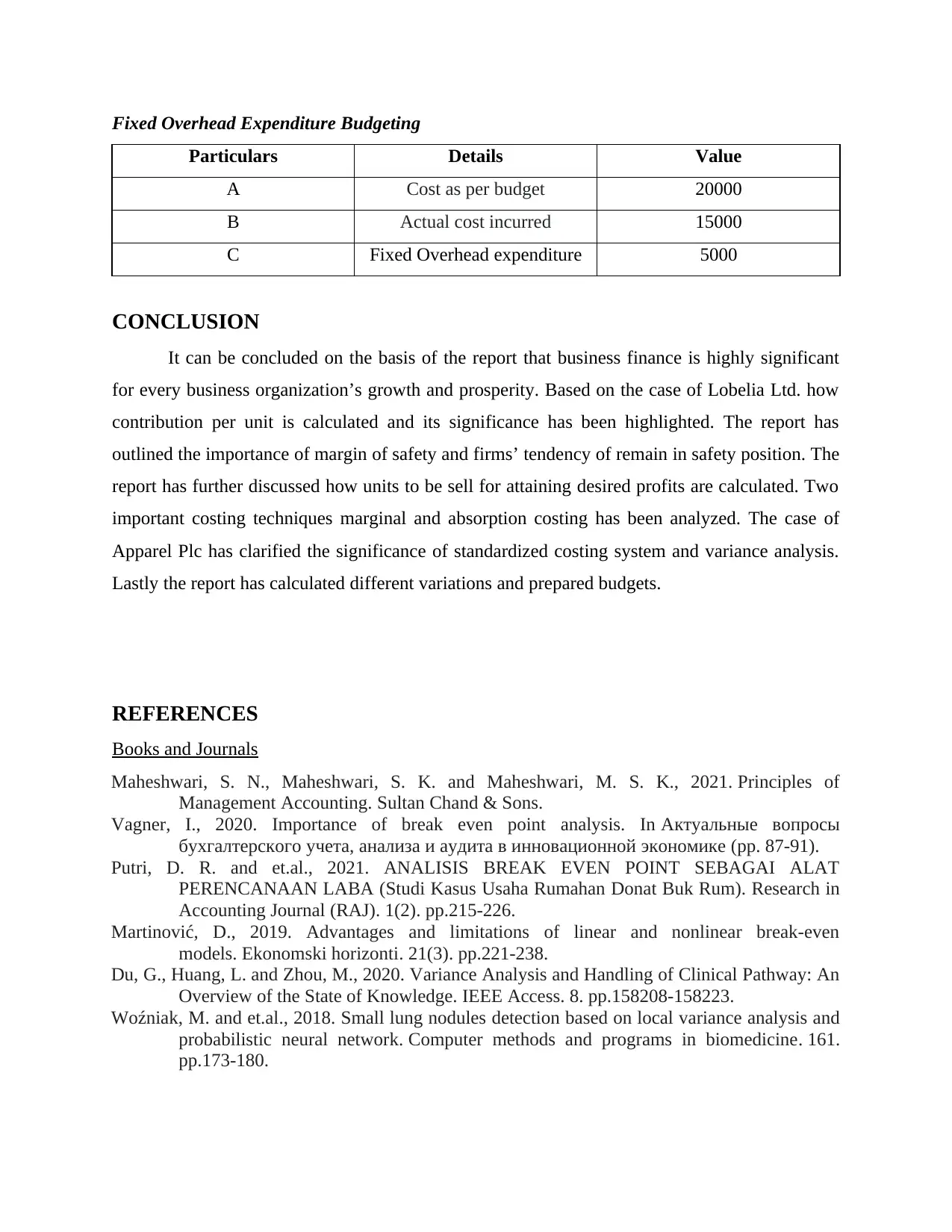
Fixed Overhead Expenditure Budgeting
Particulars Details Value
A Cost as per budget 20000
B Actual cost incurred 15000
C Fixed Overhead expenditure 5000
CONCLUSION
It can be concluded on the basis of the report that business finance is highly significant
for every business organization’s growth and prosperity. Based on the case of Lobelia Ltd. how
contribution per unit is calculated and its significance has been highlighted. The report has
outlined the importance of margin of safety and firms’ tendency of remain in safety position. The
report has further discussed how units to be sell for attaining desired profits are calculated. Two
important costing techniques marginal and absorption costing has been analyzed. The case of
Apparel Plc has clarified the significance of standardized costing system and variance analysis.
Lastly the report has calculated different variations and prepared budgets.
REFERENCES
Books and Journals
Maheshwari, S. N., Maheshwari, S. K. and Maheshwari, M. S. K., 2021. Principles of
Management Accounting. Sultan Chand & Sons.
Vagner, I., 2020. Importance of break even point analysis. In Актуальные вопросы
бухгалтерского учета, анализа и аудита в инновационной экономике (pp. 87-91).
Putri, D. R. and et.al., 2021. ANALISIS BREAK EVEN POINT SEBAGAI ALAT
PERENCANAAN LABA (Studi Kasus Usaha Rumahan Donat Buk Rum). Research in
Accounting Journal (RAJ). 1(2). pp.215-226.
Martinović, D., 2019. Advantages and limitations of linear and nonlinear break-even
models. Ekonomski horizonti. 21(3). pp.221-238.
Du, G., Huang, L. and Zhou, M., 2020. Variance Analysis and Handling of Clinical Pathway: An
Overview of the State of Knowledge. IEEE Access. 8. pp.158208-158223.
Woźniak, M. and et.al., 2018. Small lung nodules detection based on local variance analysis and
probabilistic neural network. Computer methods and programs in biomedicine. 161.
pp.173-180.
Particulars Details Value
A Cost as per budget 20000
B Actual cost incurred 15000
C Fixed Overhead expenditure 5000
CONCLUSION
It can be concluded on the basis of the report that business finance is highly significant
for every business organization’s growth and prosperity. Based on the case of Lobelia Ltd. how
contribution per unit is calculated and its significance has been highlighted. The report has
outlined the importance of margin of safety and firms’ tendency of remain in safety position. The
report has further discussed how units to be sell for attaining desired profits are calculated. Two
important costing techniques marginal and absorption costing has been analyzed. The case of
Apparel Plc has clarified the significance of standardized costing system and variance analysis.
Lastly the report has calculated different variations and prepared budgets.
REFERENCES
Books and Journals
Maheshwari, S. N., Maheshwari, S. K. and Maheshwari, M. S. K., 2021. Principles of
Management Accounting. Sultan Chand & Sons.
Vagner, I., 2020. Importance of break even point analysis. In Актуальные вопросы
бухгалтерского учета, анализа и аудита в инновационной экономике (pp. 87-91).
Putri, D. R. and et.al., 2021. ANALISIS BREAK EVEN POINT SEBAGAI ALAT
PERENCANAAN LABA (Studi Kasus Usaha Rumahan Donat Buk Rum). Research in
Accounting Journal (RAJ). 1(2). pp.215-226.
Martinović, D., 2019. Advantages and limitations of linear and nonlinear break-even
models. Ekonomski horizonti. 21(3). pp.221-238.
Du, G., Huang, L. and Zhou, M., 2020. Variance Analysis and Handling of Clinical Pathway: An
Overview of the State of Knowledge. IEEE Access. 8. pp.158208-158223.
Woźniak, M. and et.al., 2018. Small lung nodules detection based on local variance analysis and
probabilistic neural network. Computer methods and programs in biomedicine. 161.
pp.173-180.
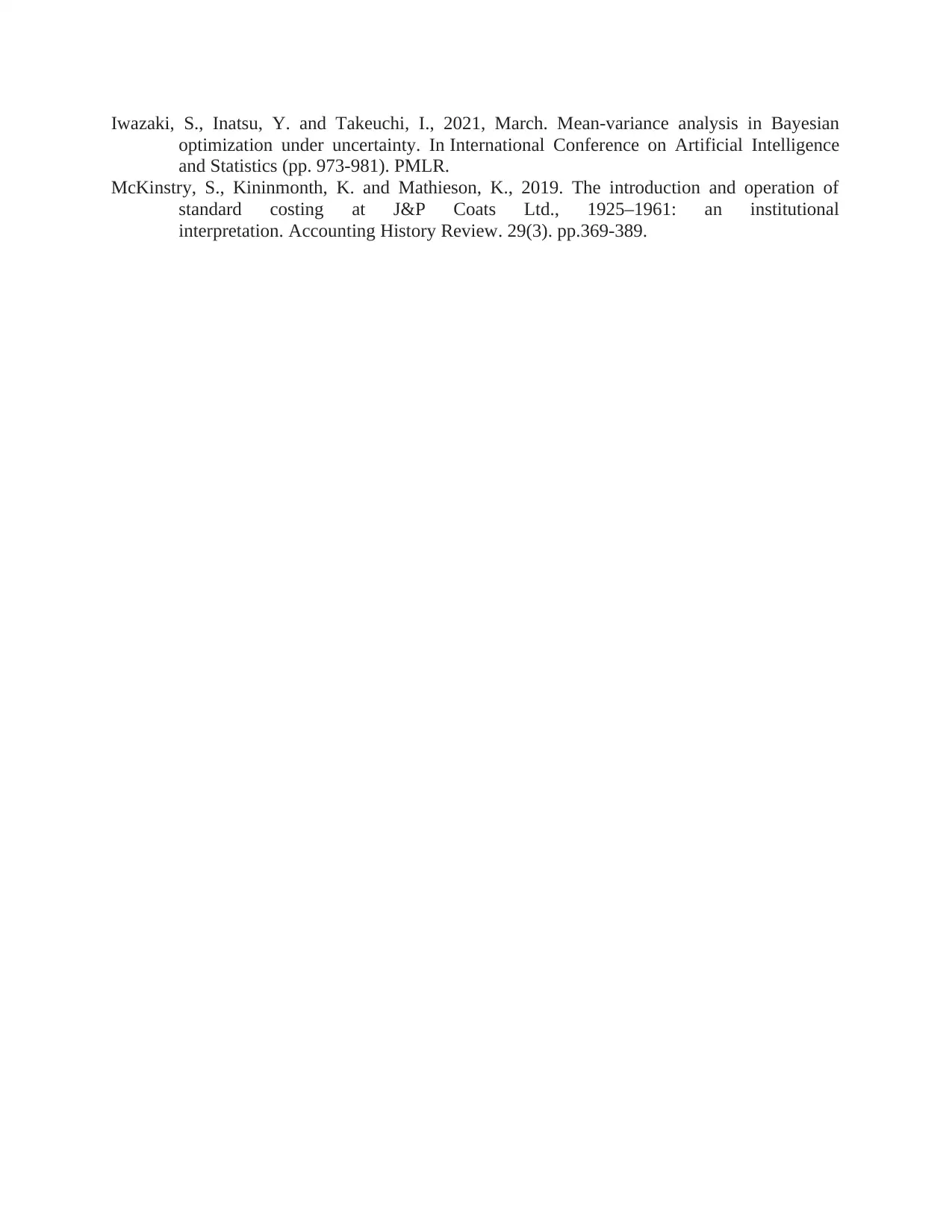
Iwazaki, S., Inatsu, Y. and Takeuchi, I., 2021, March. Mean-variance analysis in Bayesian
optimization under uncertainty. In International Conference on Artificial Intelligence
and Statistics (pp. 973-981). PMLR.
McKinstry, S., Kininmonth, K. and Mathieson, K., 2019. The introduction and operation of
standard costing at J&P Coats Ltd., 1925–1961: an institutional
interpretation. Accounting History Review. 29(3). pp.369-389.
optimization under uncertainty. In International Conference on Artificial Intelligence
and Statistics (pp. 973-981). PMLR.
McKinstry, S., Kininmonth, K. and Mathieson, K., 2019. The introduction and operation of
standard costing at J&P Coats Ltd., 1925–1961: an institutional
interpretation. Accounting History Review. 29(3). pp.369-389.
⊘ This is a preview!⊘
Do you want full access?
Subscribe today to unlock all pages.

Trusted by 1+ million students worldwide
1 out of 12
Related Documents
Your All-in-One AI-Powered Toolkit for Academic Success.
+13062052269
info@desklib.com
Available 24*7 on WhatsApp / Email
![[object Object]](/_next/static/media/star-bottom.7253800d.svg)
Unlock your academic potential
Copyright © 2020–2025 A2Z Services. All Rights Reserved. Developed and managed by ZUCOL.




